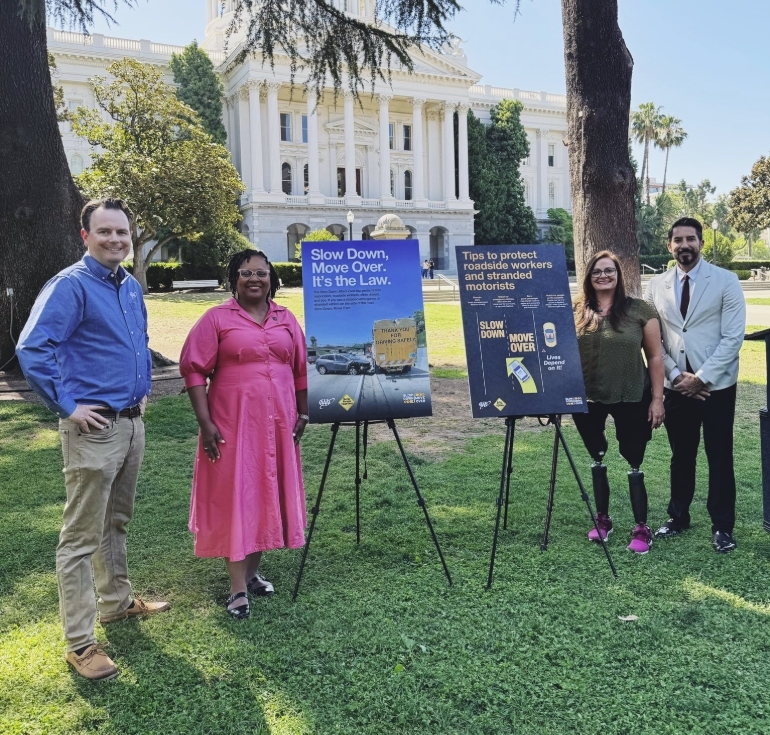California News:
A bill that expands California’s “slow down, move over law” on highways to include all stopped vehicles was signed into law by Governor Gavin Newsom on Monday.
Prior to the bill, drivers in California were only required to either slow down or move over one lane if there was a stopped emergency vehicles with lights flashing. However, a 25% increase of stopped vehicle crashes since 2014, as well as a 60% increase of fatalities of people outside disabled vehicles between 2013 and 2023, spurred both lawmakers and AAA to take action earlier this year in the form of Assembly Bill 390.
AB 390, authored by Assemblywoman Lori Wilson (D-Suisun City), expands the slow down/move over requirement to apply to all marked highway maintenance vehicles, as well as make that requirement applicable to any other stationary vehicle displaying flashing hazard lights or another warning device like cones, flares, or retroreflective devices. Essentially, if there is any car on the side of the road with lights flashing or some sort of warning device, go over a lane or slow down. According to the bill, those who violate the new law face a fine $50 for each infraction.
Wilson, along with AAA and survivors of stalled vehicle crashes, pushed forward the bill to cut down on accidents, injuries, and deaths. As noted during a hearing earlier this year, California had the second highest total deaths outside disabled vehicles between 2013 and 2023 out of all the states in the country, with only Texas recording more. The University of California at Berkeley Safe Transportation Research and Education Center (SafeTREC) was also cited, finding that, in 2022, over 1,200 individuals nationwide were killed due to drivers maneuvering too close or fast near parked cars, including 221 in California alone.
“For too long drivers in California have been put in a very dangerous situation every time their cars break down on the side of a freeway or highway,” said Wilson last month at a press conference. “It’s time the law requires motorists passing by broken down vehicles to slow down and move over a lane, when possible, to avoid any collisions. This will help protect Californians from needlessly losing their lives while dealing with automobile issues.”
In addition to Wilson and AAA, stalled vehicle crash survivor Heather Haenes gave testimony of her 2007 accident where a crash caused by a car going into her stalled vehicle on the side of the road led to both of her legs being amputated at the scene by paramedics.
“We were outside our vehicles for 30 seconds, at most, when the crash happened. It was quick. I knew it was a horrible idea to be on the side of that highway,” explained Haenes. “I’m just very lucky that it was just limbs. Fortunately, there is a lot of adaptive equipment and professionals who have helped me in the years following the crash. But even to this day, seeing people on the side of the road, I hold my breath every time.”
While the bill initially sparked some concerns over what “all stalled vehicles” meant and what constituted a highway maintenance vehicle, the clarification of it including stalled vehicles with proper flashing lights or warning devices won over lawmakers. AB 390 rapidly moved forward in the Assembly and Senate, passing each committee and floor vote with unanimous, bipartisan votes. This included floor votes this month that passed the bill 35-0 in the Senate and 73-0 in the Assembly.
The bill was brought to Governor Newsom shortly afterwards, leading to Monday when AB 390 was signed into law along with 18 other bills. As of Tuesday afternoon, neither Wilson nor AAA have given statements on AB 390’s passage, with Wilson’s office yet to respond to the California Globe.
Click this link for the original source of this article.
Author: Evan Symon
This content is courtesy of, and owned and copyrighted by, https://californiaglobe.com and its author. This content is made available by use of the public RSS feed offered by the host site and is used for educational purposes only. If you are the author or represent the host site and would like this content removed now and in the future, please contact USSANews.com using the email address in the Contact page found in the website menu.








